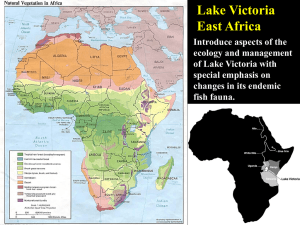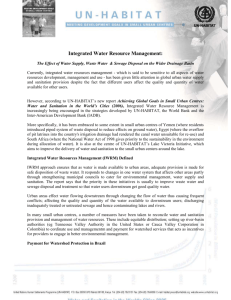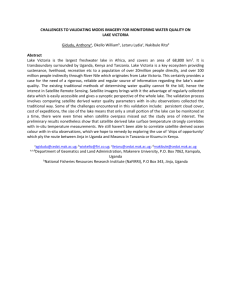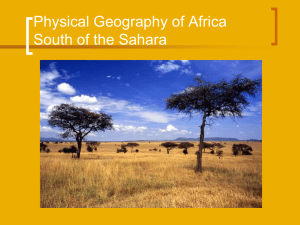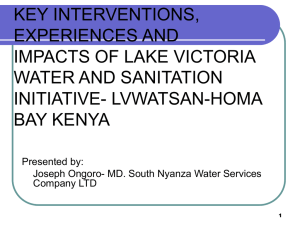LVWATSAN - UN
advertisement
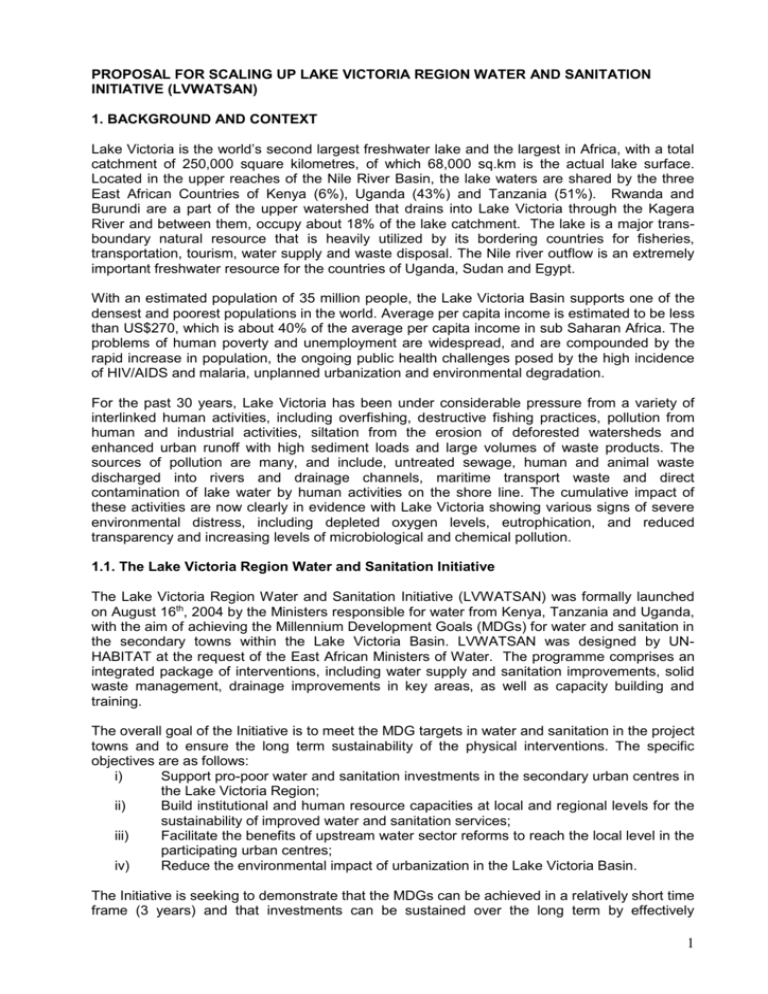
PROPOSAL FOR SCALING UP LAKE VICTORIA REGION WATER AND SANITATION INITIATIVE (LVWATSAN) 1. BACKGROUND AND CONTEXT Lake Victoria is the world’s second largest freshwater lake and the largest in Africa, with a total catchment of 250,000 square kilometres, of which 68,000 sq.km is the actual lake surface. Located in the upper reaches of the Nile River Basin, the lake waters are shared by the three East African Countries of Kenya (6%), Uganda (43%) and Tanzania (51%). Rwanda and Burundi are a part of the upper watershed that drains into Lake Victoria through the Kagera River and between them, occupy about 18% of the lake catchment. The lake is a major transboundary natural resource that is heavily utilized by its bordering countries for fisheries, transportation, tourism, water supply and waste disposal. The Nile river outflow is an extremely important freshwater resource for the countries of Uganda, Sudan and Egypt. With an estimated population of 35 million people, the Lake Victoria Basin supports one of the densest and poorest populations in the world. Average per capita income is estimated to be less than US$270, which is about 40% of the average per capita income in sub Saharan Africa. The problems of human poverty and unemployment are widespread, and are compounded by the rapid increase in population, the ongoing public health challenges posed by the high incidence of HIV/AIDS and malaria, unplanned urbanization and environmental degradation. For the past 30 years, Lake Victoria has been under considerable pressure from a variety of interlinked human activities, including overfishing, destructive fishing practices, pollution from human and industrial activities, siltation from the erosion of deforested watersheds and enhanced urban runoff with high sediment loads and large volumes of waste products. The sources of pollution are many, and include, untreated sewage, human and animal waste discharged into rivers and drainage channels, maritime transport waste and direct contamination of lake water by human activities on the shore line. The cumulative impact of these activities are now clearly in evidence with Lake Victoria showing various signs of severe environmental distress, including depleted oxygen levels, eutrophication, and reduced transparency and increasing levels of microbiological and chemical pollution. 1.1. The Lake Victoria Region Water and Sanitation Initiative The Lake Victoria Region Water and Sanitation Initiative (LVWATSAN) was formally launched on August 16th, 2004 by the Ministers responsible for water from Kenya, Tanzania and Uganda, with the aim of achieving the Millennium Development Goals (MDGs) for water and sanitation in the secondary towns within the Lake Victoria Basin. LVWATSAN was designed by UNHABITAT at the request of the East African Ministers of Water. The programme comprises an integrated package of interventions, including water supply and sanitation improvements, solid waste management, drainage improvements in key areas, as well as capacity building and training. The overall goal of the Initiative is to meet the MDG targets in water and sanitation in the project towns and to ensure the long term sustainability of the physical interventions. The specific objectives are as follows: i) Support pro-poor water and sanitation investments in the secondary urban centres in the Lake Victoria Region; ii) Build institutional and human resource capacities at local and regional levels for the sustainability of improved water and sanitation services; iii) Facilitate the benefits of upstream water sector reforms to reach the local level in the participating urban centres; iv) Reduce the environmental impact of urbanization in the Lake Victoria Basin. The Initiative is seeking to demonstrate that the MDGs can be achieved in a relatively short time frame (3 years) and that investments can be sustained over the long term by effectively 1 integrating physical infrastructure works, training and capacity building into a balanced and cohesive programme of interventions. The Initiative seeks to develop the right balance between investments on water and sanitation infrastructure in the secondary towns and capacity-building at the local and regional level to sustain programme benefits. It uses a phased approach to implementation which focuses first on immediate interventions designed to deliver immediate results followed by long term interventions requiring larger investments. Since the joining of Rwanda and Burundi in EAC, the countries have expressed a wish to join the Initiative. Preliminary assessments have been carried out in Rwanda and Burundi to identify the towns to be included in the programme and a list of 5 towns in each country has been established. LVWATSAN complements the other ongoing regional as well as country-based programmes active in the Lake Victoria Basin. Key regional initiatives undertaken in the Lake Victoria Basin include the Nile Basin Initiative (NBI), the East African Communities Organization for the Management of Lake Victoria (ECOVIC), the Lake Victoria Environmental Management Programme (LVEMP), and the Lake Victoria Local Region Local Authorities Co-operation (LVRLAC). 2. THE TARGET TOWNS 2.1. Kisumu, Kenya Kisumu is the third largest town in Kenya with a population of 597,000 persons, of which over 60% live in informal settlements. It is a key regional hub in the entire Lake Victoria Region and the Basin. Poverty levels are high at over 50%, as compared with the national average of 29%. The town experiences severe water and sanitation problems, due to low production capacity, limited service coverage of the network, compounded by low operating efficiencies of KIWASCO, especially in the area of unaccounted for water which is over 54%. In the informal settlements, there is widespread dependence on water vendors and on shallow wells, boreholes and springs which supply water of questionable quality. The town experiences recurrent outbreaks of cholera and faces ongoing public health challenges caused by deficiencies in the water and sanitation service. Kisumu town is also a major contributor to the pollution load entering Lake Victoria. 2.2. Mwanza, Tanzania Mwanza City lies along the southern shores of Lake Victoria, North West of the United Republic of Tanzania. The town has a population of over 600,000 persons and is fast developing as a centre of regional economic development. About 70% of the population live in unplanned settlements mostly in hilly areas which create difficulties to provide water and sanitation services and generates pollution to the water sources. There is low sewerage coverage and unwillingness of the people to get connected to the sewerage network. The responsibility for water and sewerage services lies with MWAUWASA, a water authority established on 1st July 1996 which became fully autonomous since 1998. It provides water supply and sewerage services in Mwanza City & Kisesa in Magu District. Its service area covers about 84% of the population of the 2 districts and the township. Only 8% of the population are connected to the sewerage system. There is insufficient distribution network and water losses are between 36% 40% due largely to old pipes. 2.3. Kampala, Uganda Kampala is the capital of Uganda with a population of 2.5 million persons. As the major economic, commercial and administrative center in Uganda, the city is experiencing an extremely rapid rate of urbanization of over 5.6%. Over 60% of the city population lives in informal settlements with poor water and sanitation coverage. Kampala water supply coverage 2 now extends beyond KCC’s Municipal boundaries into the districts of Wakiso and Mukono. Water coverage in the Kampala Water Supply and Sewerage Service Area is now at 70%, while sewerage coverage is at only 6 %, septic tank coverage 18 %, pit latrine 32 (not shared), shared pit latrines 38 %. 2.4. Kigali, Rwanda Kigali city is the capital of Rwanda with a population of about 800,000 persons. The city is facing a problem of shortage in drinking water and poor sanitation. People living in suburban areas of Kigali are spending many days without water supply in their houses, and when they have to buy it from water vendors the price is very high. The current water production stands at 35,000 cu.m; but there is no sewerage network. Solid Waste collection is by private operators. There is a need for production of another 35,000 cu.m to meet the requirement of 70,000 cu.m. Owing to earlier poor planning, the city lacks sewerage and sewerage systems. Liquid Waste are solely handled through septic and soak away pits as a situation that does not allow sustainable waste handling and treatment. The ground in the city is getting saturated and if nothing is done very soon, the city population is going to face serious sanitation catastrophe. 2.5. Gitega, Burundi Gitega is the second largest town in Burundi with a current population is 150,000 people. The town’s population is increasing at about 6% a year and is expected to reach around 300,000 inhabitants in 2020. About 80% of the population is living in conditions of poverty, without any water and sanitation infrastructure. Lack of access to piped water forces some of the population to rely on water from vendors who sell drinking water at very high prices compared to the cost of REGIDESO (the power and water utility in Burundi). Most town residents rely on streams, wells and other sources which are polluted. There are widespread problems of water borne diseases caused by poor water and sanitation. 3. PROPOSED SCOPE OF INFRASTRUCTURE INVESTMENT An indicative Investment plan is proposed amounting to USD. 313 Million broken down by country, as follows. Uganda – USD 122.5 Million Kenya – USD 71.8 Million Rwanda- USD 45 Million Burundi – USD 24.2 Million Tanzania - USD 49.3 Million This will be complemented by the investment package from the AfDB for the 15 secondary towns which is expected to be of the order of US$65 million. The investment plan shows a relatively large allocation for Kampala which is the capital city of Uganda with a population at least 4 times the population of the other large towns. For detailed breakdown see the annexed table 1. 4. TRAINING AND CAPACITY BUILDING In order to improve sustainability and efficiency of the proposed investments, Training and Capacity Building will form a key component of the programme including:- Utility Management, - Integrated Water Resources Management, - Stakeholder Participation, - Urban Planning, - Gender Mainstreaming and enhancing the role of Women and Vulnerable Groups. - Participatory Monitoring and Evaluation. 3 5. FUNDING MODALITIES The Loan component has to be channeled through respective Ministries of Finance, including the possible Grant component from EIB to lower the rate of Interest. This is to be formalized during Loan negotiations. Grant funding from the EU-Africa Infrastructure Trust Fund will be maximized to address the training and capacity building and the extension of services to the urban poor. 6. COORDINATION AND IMPLEMENTATION ARRANGEMENTS Coordination and implementation arrangements should maintain and enhance the regional dimension of the programme. The envisaged roles of the National Governments, the Lake Victoria Basin Commission, UN-HABITAT and the national water boards and utility companies are as follows: 6.1. National Governments National Governments will be responsible for the formulation of policy, integrating the projects into national water and sanitation sector programmes, project planning and design and the setting of national standards. The respective Finance Ministries will have primary responsibility for ensuring that the programme is integrated into the national budgeting framework, negotiating and finalizing the loan packages and on-lending agreements (if applicable), funds management and disbursements, allocating counterpart funding and national resource mobilization. 6.2. Lake Victoria Basin Commission The Lake Victoria Basin Commission will be responsible for regional coordination and will be the political focal point for interface with governments. LVBC will also ensure effective coordination with other regional development initiatives in the Lake basin, such as the Lake Victoria Environmental Management Programme. The Basin Commission will also be responsible for the harmonization of environmental management policies, standards and practices, assistance with resource mobilization and enhancing the role of the programme in the promotion of regional integration, in collaboration with other stakeholders, including UN-HABITAT. 6.3. UN-HABITAT The key role of UN-Habitat will be to provide technical assistance (through earmarked contributions to the Water, Sanitation and Infrastructure Trust Fund) for training and capacity building focusing on, i) utility management, ii) community participation techniques, iii) gender mainstreaming and the role of women and vulnerable groups, iv) advocacy and awareness issues, and v) urban planning. In this regard, UN-HABITAT will prepare a project document to provide a basis for the mobilization of Technical Assistance funds to finance these activities from the EIB and other donors, as appropriate. UN-HABITAT will also assist the countries in setting up a monitoring system to provide baseline socio-economic data and monitor progress in meeting the MDGs. UN-HABITAT will provide further support for the mobilization and management of grant funds through the Water and Sanitation Trust Fund for the extension of services to the low income settlements of the target towns. 6.4. Water Service Boards and Utilities Water Service Boards and Utilities and City Councils will be the main implementing agencies for the national components of the programme. They will be responsible for preparation of the detailed designs, engagements of consultants, progress reporting operational and maintenance of facilities and ensuring sustainability of the long term investment. 4 7. KEY ACTION POINTS FOR FOLLOW- UP UN-Habitat, LVBC and EIB to undertake the formulation of the overall Investment Proposal; in consultation with the 5 governments. Initiate consultation and negotiations with respective Ministries of Finance to incorporate the programme into the National Budget Frameworks; Commencement of Technical Projects preparation (feasibility studies, detailed designs and implementation documents) using the EIB grant facility EIB, LVBC, AfDB and UN-Habitat to Convene a Donor Conference within three months to mobilize additional funding to complement possible EIB financing; 8. PROPOSED TIME SCHEDULE Programme Formulation by October 2009 Incorporation into National Budgeting Process by December 2009 Capacity Building Launch by January 2010 5 Table 1: Proposed Infrastructure Investment Component 1. Water Supply - Intake / Treatment - - Distribution Network - New Rehab Rehab (urban) Rehab (Peri-urban/ informal) New (Urban) New (peri-urban) Storage Controls/ Regulation 2. Sewerage and Sanitation - Treatment - Sub-category Networks On-site Sanitation Small Bore sewers 3. Urban Catchment Management - Environmental san management – drainage - Water Source catchment protection - Water quality monitoring/ testing Uganda Kenya 26 13 32 13 40 13 3 5 5 1 10 Rehab New Rehab (urban) Rehab (peri-urban) New (urban) New (peri-urban) Peri-urban Peri-urban Country Tanzania Rwanda Burundi 2.5 0.5 68.5 13 36 14.83 12 2 0.6 3 0.8 1.7 21.16 20 17.8 2.8 16 4.4 20.4 1.6 0.7 0.2 15 1.6 13.18 5.35 0.4 8 1.9 4 1.33 4.56 5 0.1 5 Total (USD) 10 12.38 0.15 8 0.5 1 2.5 1 1 0.3 4.8 3.5 1 1 0.2 5.7 6 4. Capacity Building and Training - Staff training/ water utility - Institutional support - M&E - Gender Mainstreaming 5. Solid Waste Management - Communication and Awareness - Equipment Support - Capacity Building and Training 6. Others TOTAL 1.5 0.5 1 2 0.5 0.4 0.3 0.3 0.4 2 1 1 2 2 0.1 3 1.5 1 0.1 2 122.5 71.8 15.3 49.22 1.5 3.9 3.3 1.8 0.4 0.5 2 2.6 1.2 0.4 1.1 0.5 6.3 2.5 45 1.2 24.2 18.5 312.72 7 SUMMARY Activity 1. Proposed Scope of Infrastructure Investments 2. Training and Capacity Building 3. Funding Modalities 4. Coordination and implementation Management 5. Key Action Points for Followup Uganda 107 Kenya 64.1 Country Tanzania 22.42 Rwanda 40 Burundi 15.9 15.5 5.8 11.5 5 5.1 - Concessional Loan through GoU - Grants - Loan by Govt (Treasury) to on-lend - Grant to Treasury then channeled to LVSWSB - Min. of Finance – borrow and coordinate - MOWI – policy, coordination and supervision - LVSWSB –implement - UN-Habitat – TA support and capacity building - LVBC – regional coordination - Feasibility study - Detailed Design - Appraisal by partner EIB - Agreement with MoF Basket fund Sector Budget Support Basket Fund Ministry of Water, UN-Habitat, LVBC Ministry of Finance NINECOFIN – Financial Coordination MININFRA- Technical Coordination ELECTROGAZ – Implement UN-Habitat- TA and Capacity Building Finance Ministry, M.E.E REGIDESO SETEMU UN-HABITAT - Infrastructure investments and capacity building relating to NWSC to be coordinated by NWSC - others coordinated and implemented through line institutions - 6. Others Feasibility study Detailed Design Appraisal by partner EIB Agreement with MoF - Feasibility study Detailed Design Appraisal by partner EIB Agreement with MoF Remarks - Feasibility study Detailed Design Appraisal by partner EIB Agreement with MoF - Feasibility study Detailed Design Appraisal by partner EIB Agreement with MoF 14.30 8
